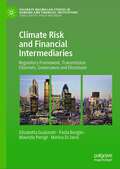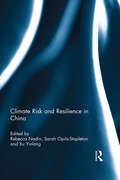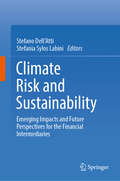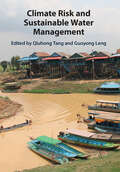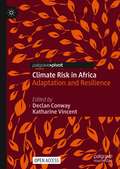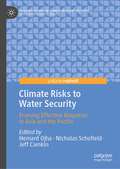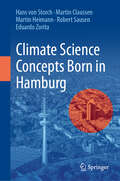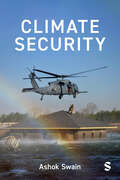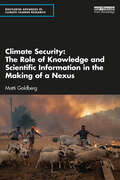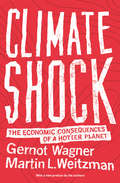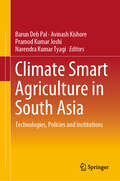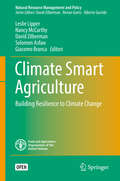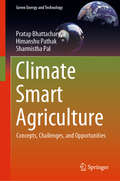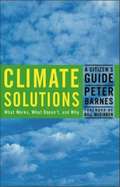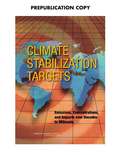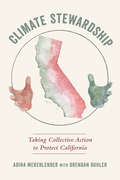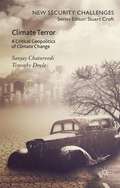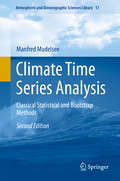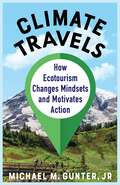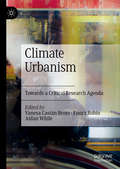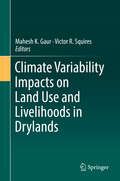- Table View
- List View
Climate Risk Management in Agriculture: Monthly and Seasonal Forecast Application
by U. C. Mohanty Palash Sinha M. M. Nageswara Rao Dillip Kumar Swain K. K. SinghSustainable agricultural production is vital for food security and agricultural productivity. It is greatly influenced by weather and climate conditions. This book focuses on understanding weather and climate systems and crop yield productions, including integrated weather-crop prediction systems for climate risk management in agriculture. It examines the impact of climate change and its variability on different crops, and possible ways to minimize the loss for farmers. This book also describes different weather and climate hazards, including the fundamentals of weather/climate prediction systems and numerical weather prediction (NWP) models. It presents the need for seamless weather/climate predictions and their impact on agriculture. The status and availability of different monthly and seasonal scale forecasts worldwide is explored and how the forecasting models or products can be evaluated using statistical methods. The book concisely elucidates systematic model bias removal techniques and a reliable approach based on multi-statistics in producing a single forecast from the multi-model grand ensemble. Since crop models need daily weather sequence, several standard disaggregation methods for generating daily weather sequences from monthly/seasonal products are presented. This book describes several aspects that are needed for agricultural practices and crop modelling. It encapsulates different components of crop models and their application, preparation methods of Crop Weather Calendar, application of disaggregated weather sequence in crop models, and generation of Climate Risk Matrices (CRM). A detailed methodology is presented for hands-on practice, including downloading and processing data, model evaluation and bias corrections, generating a single forecast, disaggregation, and preparing CRM based on crop model products. This book contains a total 11 chapters and appeals to students, researchers, scientists, and operational agencies.
Climate Risk and Financial Intermediaries: Regulatory Framework, Transmission Channels, Governance and Disclosure (Palgrave Macmillan Studies in Banking and Financial Institutions)
by Elisabetta Gualandri Paola Bongini Maurizio Pierigè Marina Di JanniClimate change is defining structural modifications that affect the economy and the financial system. Within Europe, supervisors and supervised entities are increasingly focusing on the consequences of environmental, social and governance (ESG) risks, as they impact the soundness and stability of the financial system or interfere with the transmission channels of monetary policy and price stability, as well as raising sustainability financing issues.Focusing on climate-related risks within the broader theme of the ESG risks, this book, structured in six chapters, analyzes the evolving overall regulatory framework, the climate risk transmission channels, the peculiarities of climate risk transmission channels with reference to specific business models of financial intermediaries, and the governance and disclosure implications of climate risks. It will be of interest to academics, practitioners, and students in the fields of banking, financial services, sustainability, ESG, andclimate risk.
Climate Risk and Resilience in China
by Rebecca Nadin Sarah Opitz-Stapleton Xu YinlongChina has been subject to floods, droughts and heat waves for millennia; these hazards are not new. What is new is how rapidly climate risks are changing for different groups of people and sectors. This is due to the unprecedented rates of socio-economic development, migration, land-use change, pollution and urbanisation, all occurring alongside increasingly more intense and frequent weather hazards and shifting seasons. China’s leadership is facing a significant challenge – from conducting and integrating biophysical and social vulnerability and risk assessments and connecting the information from these to policy priorities and time frames, to developing and implementing policies and actions at a variety of scales. It is within this challenging context that China’s policy makers, businesses and citizens must manage climate risk and build resilience. This book provides a detailed study of how China has been working to understand and respond to climatic risk, such as droughts and desertification in the grasslands of Inner Mongolia to deadly typhoons in the mega-cities of the Pearl River Delta. Using research and data from a wide range of Chinese sources and the Adapting to Climate Change in China (ACCC) project, a research-to-policy project, this book provides a fascinating glimpse into how China is developing policies and approaches to manage the risks and opportunities presented by climate change. This book will be of interest to those studying global and Chinese climate change policy, regional food, water and climate risk, and to policy advisors.
Climate Risk and Sustainability: Emerging Impacts and Future Perspectives for the Financial Intermediaries
by Stefano Dell’Atti Stefania Sylos LabiniThis book analyzes recent trends and upcoming challenges in corporate governance and risk management in financial institutions with a particular focus on their rule in promoting a sustainable economic growth model. The impact of negative events caused by environmental and climate change can have significant consequences for the real economy and the financial system. This relevant impact has been affirmed several times by financial regulators and supervisors and has led to set objectives and encourage practices in line with Environmental, Social and Governance (ESG) issues in order to push both financial and nonfinancial firms towards a sustainable and circular economic model. The issue of climate risk change related to finance has launched a wide political debate at international and European level and was deepened investigated in literature. The analysis will be conducted at an international level, with a particular focus on Europe. The interdisciplinary will allow to address multiple issues under three, in our opinion, indispensable different profiles: i) managerial ii) mathematical (quantitative) and iii) legal. In this direction, the research aims to develop new knowledge and skills through the integration and cooperation between the different sectors and disciplines. In the scope of Marie Sklodowska-Curie Actions, the research would deepen the role of finance in accelerating the green transition towards a circular, climate-neutral and sustainable economy.
Climate Risk and Sustainable Water Management
by Qiuhong Tang Guoyong LengClimate change is leading to changing patterns of precipitation and increasingly extreme global weather. There is an urgent need to synthesize our current knowledge on climate risks to water security, which in turn is fundamental for achieving sustainable water management. Climate Risk and Sustainable Water Management discusses hydrological extremes, climate variability, climate impact assessment, risk analysis, and hydrological modelling. It provides a comprehensive interdisciplinary exploration of climate risks to water security, helping to guide sustainable water management in a changing and uncertain future. The relevant theory is accessibly explained using examples throughout, helping readers to apply the knowledge learned to their own situations and challenges. This textbook is especially valuable to students of hydrology, resource management, climate change, and geography, as well as a reference textbook for researchers, civil and environmental engineers, and water management professionals concerned with water-related hazards, water cycles, and climate change.
Climate Risk in Africa: Adaptation and Resilience
by Declan Conway Katharine VincentThis open access book highlights the complexities around making adaptation decisions and building resilience in the face of climate risk. It is based on experiences in sub-Saharan Africa through the Future Climate For Africa (FCFA) applied research programme. It begins by dealing with underlying principles and structures designed to facilitate effective engagement about climate risk, including the robustness of information and the construction of knowledge through co-production. Chapters then move on to explore examples of using climate information to inform adaptation and resilience through early warning, river basin development, urban planning and rural livelihoods based in a variety of contexts. These insights inform new ways to promote action in policy and praxis through the blending of knowledge from multiple disciplines, including climate science that provides understanding of future climate risk and the social science of response through adaptation.The book will be of interest to advanced undergraduate students and postgraduate students, researchers, policy makers and practitioners in geography, environment, international development and related disciplines.
Climate Risks to Water Security: Framing Effective Response in Asia and the Pacific (Palgrave Studies in Climate Resilient Societies)
by Hemant Ojha Nicholas Schofield Jeff CamkinIn Asia and the Pacific, climate change is now a well-recognised risk to water security but responses to this risk are either under reported, or continue to be guided by the incremental or business as usual approaches. Water policy still tends to remain too narrow and fragmented, compared to the multi-sectoral and cross-scalar nature of risks to water security. What’s more, current water security debates tend to be framed in discipline specific or academic ways, failing to understand decision making and problem-solving contexts within which policy actors and partitioners have to operate on a daily basis. Much of the efforts to date has focussed on assessing and predicting the risks in the context of increasing levels of uncertainty. There is still limited analysis of emerging practices of risks assessment and mitigation in different contexts in Asia and the Pacific.Going beyond the national scales and focussing on several socio-ecological zones, this book captures stories written by engaged scholars on recent attempts to develop cross-sectoral and cross-scaler solutions to assess and mitigate risks to water security across Asia and the Pacific. Identifying lessons from successes and failures, it highlights management and strategic lessons that water and climate leaders of Asia and the Pacific need to consider. This book showcases reflective and analytical thought pieces written by key actors in the climate and water spaces. Several critical socio-ecological zones are covered – from Pakistan in the west to pacific islands in the east. The chapters clearly identify strategies for improvement based on the analysis of emerging responses to climate risks to water security and gaps in current practices. The book will include an editorial introduction and a final synthesis chapter to ensure clear articulation of common themes and to highlight the overall messages of the book.
Climate Science Concepts Born in Hamburg
by Martin Heimann Martin Claussen Hans von Storch Robert Sausen Eduardo ZoritaSince the foundation of the Max Planck Institute in 1975 with the now-Nobel laureate Klaus Hasselmann as founding director, the climate science in Hamburg has seen a remarkable boost. Various ideas were brought forward, implemented and tested. Many of them ignited interest in the global scientific community, thus adding significant momentum to the development of modern climate science. The participants of the remarkable development since 1975 have come together to identify these concepts “born in Hamburg”. In an introductory chapter, the historical development, including other significant developments of climate science in the late 19th and early 20th century are addressed. The main part consists of chapters addressing the development of key innovative concepts. These are chosen to describe ideas which have been suggested by scientists while working in Hamburg and have been taken up by the international community in applications and advancements (such as the stochastic framing of dynamics and analysis, adding carbon cycles to climate models, multiple equilibria in climate models, anomaly coupling, downscaling, and constructed proxies). These ideas may not in all cases have been strictly new, or “firsts”, but they were the Hamburg publications which made the difference. The book is mostly a book on scientific concepts and ideas, less so a general history of climate science in Hamburg.
Climate Science for Serving Society: Research, Modeling and Prediction Priorities
by James W. Hurrell Ghassem R. AsrarThis volume offers a comprehensive survey and a close analysis of efforts to develop actionable climate information in support of vital decisions for climate adaptation, risk management and policy. Arising from submissions and discussion at the 2011 Open Science Conference (OSC) of the World Climate Research Program (WCRP), the book addresses research and intellectual challenges which span the full range of Program activities.
Climate Security
by Ashok SwainHow does the climate crisis relate to global security issues? What impact do increasing temperatures, droughts, sea level rises and extreme weather have on borders, war, migration and unrest? This nuanced, urgent book cuts into the heart of this relationship, packed with global examples, from glacier movements destabilizing borders, to misinformation driving political apathy around the climate. You will encounter new, provocative ideas such as the carbon footprint of the military, the pressing need for the Global South to adapt, not blame, and the need for strong and visionary leadership in climate negotiations. Situated on the cutting edge of the climate debate, this book will revolutionize your perspective on global security, challenge deep-rooted assumptions and ignite you critical thinking.
Climate Security
by Ashok SwainHow does the climate crisis relate to global security issues? What impact do increasing temperatures, droughts, sea level rises and extreme weather have on borders, war, migration and unrest? This nuanced, urgent book cuts into the heart of this relationship, packed with global examples, from glacier movements destabilizing borders, to misinformation driving political apathy around the climate. You will encounter new, provocative ideas such as the carbon footprint of the military, the pressing need for the Global South to adapt, not blame, and the need for strong and visionary leadership in climate negotiations. Situated on the cutting edge of the climate debate, this book will revolutionize your perspective on global security, challenge deep-rooted assumptions and ignite you critical thinking.
Climate Security: The Role of Knowledge and Scientific Information in the Making of a Nexus (Routledge Advances in Climate Change Research)
by Matti GoldbergThis book presents an empirical study of the role of knowledge in the making of the climate-security nexus. Climate change might give the Soviet Union a competitive advantage in the Cold War. Extreme droughts contributed to wars in Darfur, Syria or Yemen. Melting sea ice creates geopolitical risks. Russia’s climate-destroying hydrocarbons enabled its invasion of Ukraine. These are just some of the many ways in which climate change and conflicts have been linked into a climate-security nexus. In this innovative book, Matti Goldberg considers how such connections are constructed and asks to what extent they are driven by evidence and science. Goldberg describes the tools used to present the wars of Darfur and Syria as “climate wars” and considers the fragmented role of the sciences in those presentations as well as the resulting patterns of influence and marginalization of impacted populations. The author also highlights how the international community can better integrate the situations of people at the frontlines of climate change into policymaking and, based on an analysis of the dynamic nature of power, identifies potential entry points for positive change. This book is a must-read for researchers interested in climate-security links, in science-policy interfaces, and in the formation of nexuses of issues in international politics. It is also of interest to practitioners working on the climate-security nexus and science-policy interfaces.
Climate Shock
by Gernot Wagner Martin L. WeitzmanIf you had a 10 percent chance of having a fatal car accident, you'd take necessary precautions. If your finances had a 10 percent chance of suffering a severe loss, you'd reevaluate your assets. So if we know the world is warming and there's a 10 percent chance this might eventually lead to a catastrophe beyond anything we could imagine, why aren't we doing more about climate change right now? We insure our lives against an uncertain future--why not our planet?In Climate Shock, Gernot Wagner and Martin Weitzman explore in lively, clear terms the likely repercussions of a hotter planet, drawing on and expanding from work previously unavailable to general audiences. They show that the longer we wait to act, the more likely an extreme event will happen. A city might go underwater. A rogue nation might shoot particles into the Earth's atmosphere, geoengineering cooler temperatures. Zeroing in on the unknown extreme risks that may yet dwarf all else, the authors look at how economic forces that make sensible climate policies difficult to enact, make radical would-be fixes like geoengineering all the more probable. What we know about climate change is alarming enough. What we don't know about the extreme risks could be far more dangerous. Wagner and Weitzman help readers understand that we need to think about climate change in the same way that we think about insurance--as a risk management problem, only here on a global scale.Demonstrating that climate change can and should be dealt with--and what could happen if we don't do so--Climate Shock tackles the defining environmental and public policy issue of our time.
Climate Smart Agriculture in South Asia: Technologies, Policies and Institutions
by Barun Deb Pal Avinash Kishore Pramod Kumar Joshi Narendra Kumar TyagiThis book discusses various climate smart agro-technologies, their technical and economic feasibility across heterogeneous agro-climatic conditions, assessing farmers’ willingness to adopt those technologies, impact of climate smart technology in agricultural production and possible policy and investment opportunities to upscale it. Containing eight chapters, the book starts with a discussion about the methodological aspects of priority setting of the farm technologies across various regions of South Asia including Eastern Indo-Gangetic plain, Western Indo-Gangetic Plain and arid regions. Using data from field based trials and expert solicitations, the book next deliberates on a list of feasible technologies, assessed by constructing climate smart Feasibility Index. Further on, there is an analysis, using stated preference method, of the behaviour of farmers in adopting climate smart technologies. Preference of women farmers has been given a special focus in this book. After discussing the method priority setting of the farm technologies, impact of climate smart technologies has been analysed using real time data. Government policies have been reviewed with the view of achieving climate smart agriculture in South Asia. The book also describes the optimization modelling framework for investment allocation and technology prioritization. The model integrates both the bio-physical and the economic optimization model to capture the agro-climatic heterogeneity within the region and the variability of technical feasibility across regions and crops. Results of this model will help policy makers to identify how much to invest, where to invest and what technologies to prioritize for investments.
Climate Smart Agriculture: Building Resilience to Climate Change (Natural Resource Management and Policy #52)
by David Zilberman Leslie Lipper Nancy Mccarthy Solomon Asfaw Giacomo BrancaThis book is open access under a CC BY-NC-SA 3. 0 IGO license. The book uses an economic lens to identify the main features of climate-smart agriculture (CSA), its likely impact, and the challenges associated with its implementation. Drawing upon theory and concepts from agricultural development, institutional, and resource economics, this book expands and formalizes the conceptual foundations of CSA. Focusing on the adaptation/resilience dimension of CSA, the text embraces a mixture of conceptual analyses, including theory, empirical and policy analysis, and case studies, to look at adaptation and resilience through three possible avenues: ex-ante reduction of vulnerability, increasing adaptive capacity, and ex-post risk coping. The book is divided into three sections. The first section provides conceptual framing, giving an overview of the CSA concept and grounding it in core economic principles. The second section is devoted to a set of case studies illustrating the economic basis of CSA in terms of reducing vulnerability, increasing adaptive capacity and ex-post risk coping. The final section addresses policy issues related to climate change. Providing information on this new and important field in an approachable way, this book helps make sense of CSA and fills intellectual and policy gaps by defining the concept and placing it within an economic decision-making framework. This book will be of interest to agricultural, environmental, and natural resource economists, development economists, and scholars of development studies, climate change, and agriculture. It will also appeal to policy-makers, development practitioners, and members of governmental and non-governmental organizations interested in agriculture, food security and climate change.
Climate Smart Agriculture: Concepts, Challenges, and Opportunities (Green Energy and Technology)
by Pratap Bhattacharyya Himanshu Pathak Sharmistha PalThe books deals with the critical issues of climate change and its impact on agriculture and proposes climate smart agriculture as the probable solution to this issue. It discusses the impact of climate change and greenhouse gases emission on agriculture. It covers the strategies and management options of climate smart agriculture by including crop, water, soil, and energy management with examples and case studies. The subject matter has been presented in a very lucid language, containing real-time case studies, questions and few solved problems in specific chapters. The text is further enriched with simple line diagram and figures, chart, flow charts and tables. The book is primarily intended for researchers and professionals in the research areas of environmental science, agriculture, soil science, etc.
Climate Solutions: A Citizen's Guide
by Peter BarnesIn 2006, NASA's top climate scientist warned that we have at most a decade to turn the tide on global warming. After that, James Hansen said, all bets are off. Temperature rises of 3 to 7 degrees Fahrenheit will "produce a different planet." If Hansen is right--and most scientists think he is--then every year lost is a year closer to the precipice. In more positive terms, we have one last chance-but one chance only-to save the planet. This guide is about that last chance. It's a result of hundreds of how-do-we-do-this-right discussions over many years. Author and entrepreneur Peter Barnes want to share what he's learned in these discussions because the climate crisis must be solved now, and popular understanding is a prerequisite to getting a solution that actually solves the problem. As a result of these numerous discussions, Barnes come to appreciate that climate policy isn't as simple as one would want it to be. But it's not rocket science, either. When details get complicated, the key is to remember what we, as a nation and a species, must very quickly do: install a workable and lasting system for limiting our use of the atmosphere.
Climate Stabilization Targets: Emissions, Concentrations, and Impacts over Decades to Millennia
by National Research Council of the National AcademiesEmissions of carbon dioxide from the burning of fossil fuels have ushered in a new epoch where human activities will largely determine the evolution of Earth's climate. Because carbon dioxide in the atmosphere is long lived, it can effectively lock the Earth and future generations into a range of impacts, some of which could become very severe. Emissions reductions decisions made today matter in determining impacts experienced not just over the next few decades, but in the coming centuries and millennia. According to Climate Stabilization Targets: Emissions, Concentrations, and Impacts Over Decades to Millennia, important policy decisions can be informed by recent advances in climate science that quantify the relationships between increases in carbon dioxide and global warming, related climate changes, and resulting impacts, such as changes in streamflow, wildfires, crop productivity, extreme hot summers, and sea level rise. One way to inform these choices is to consider the projected climate changes and impacts that would occur if greenhouse gases in the atmosphere were stabilized at a particular concentration level. The book quantifies the outcomes of different stabilization targets for greenhouse gas concentrations using analyses and information drawn from the scientific literature. Although it does not recommend or justify any particular stabilization target, it does provide important scientific insights about the relationships among emissions, greenhouse gas concentrations, temperatures, and impacts. Climate Stabilization Targets emphasizes the importance of 21st century choices regarding long-term climate stabilization. It is a useful resource for scientists, educators and policy makers, among others.
Climate Stewardship: Taking Collective Action to Protect California
by Adina MerenlenderAs climate disruption intensifies the world over, Californians are finding solutions across a diversity of communities and landscapes. Though climate change is a global existential threat, we cannot wait for nation-states to solve the problem when there are actions we can take now to protect our own communities. In Climate Stewardship: Taking Collective Action to Protect California, readers are invited on a journey to discover that all life is interconnected and shaped by climate and to learn how communities can help tackle climate change. Climate Stewardship shares stories from everyday people and shows how their actions enhance the resilience of communities and ecosystems across ten distinct bioregions. Climate science that justifies these actions is woven throughout, making it easy to learn about Earth's complex systems. The authors interpret and communicate these stories in a way that is enjoyable, inspiring, and even amusing. California is uniquely positioned to develop and implement novel solutions to widespread climate challenges, owing to the state's remarkable biogeographic diversity and robust public science programs. Produced in collaboration with the UC California Naturalist Program, Climate Stewardship focuses on regenerative approaches to energy, agriculture, and land and water use across forested, agricultural, and urban landscapes. The authors' hopeful and encouraging tone aims to help readers develop a sense that they, too, can act now to make meaningful change in their communities.
Climate System Dynamics and Modelling
by Hugues GoosseThis textbook presents all aspects of climate system dynamics, on all timescales from the Earth's formation to modern human-induced climate change. It discusses the dominant feedbacks and interactions between all the components of the climate system: atmosphere, ocean, land surface and ice sheets. It addresses one of the key challenges for a course on the climate system: students can come from a range of backgrounds. A glossary of key terms is provided for students with little background in the climate sciences, whilst instructors and students with more expertise will appreciate the book's modular nature. Exercises are provided at the end of each chapter for readers to test their understanding. This textbook will be invaluable for any course on climate system dynamics and modeling, and will also be useful for scientists and professionals from other disciplines who want a clear introduction to the topic.
Climate Terror
by Timothy Doyle Sanjay ChaturvediClimate Terror investigates the highly differentiated geographical politics of global warming. It explores how fear-inducing climate change discourses could result in new forms of dependencies, domination and militarized 'climate security'. In this revealing study from Chaturvedi and Doyle, the concept of environmental security is brought to life through cases of the most pressing environmental issues confronting the Global South, which are creating desperate realities for billions of people. The book proposes the following key questions, crucial to our understanding of this issue: Can the climate discourse be re-configured to provide a place where issues of environmental justice and sovereignty are paramount, rather than neo-liberal responses to climate? Can climate change give a voice to the global periphery, and can it be used as a vehicle for emancipation? Chaturvedi and Doyle's study concludes by taking note of the more optimistic response of 'emancipatory' groups and networks to concepts such as climate justice and climate debt, and the ways in which these groups have attempted to use this global climate moment for more democratic purposes. Is the climate story, regardless of its diverse intentions, a discourse now captured by the affluent North to control the development of the Global South? Has the emancipatory moment now passed or is there still hope for the re-emergence of subaltern perspectives on climate futures? The authors further discuss the deployment of terror vocabulary to address climate change, which is a part of refurbished designs and technologies of control, regulation and domination in a neo-liberal, post-political, globalized world marked by profound asymmetries in terms of economic growth and human development. They argue for an increased understanding of the environment, not as an external enemy force, but as adiverse nature that is inclusive of people, a nature that has the potential to provide secure access to citizens of all countries to basic nutrition, adequate access to health, appropriate shelter, and a security to practice a diverse range of livelihoods.
Climate Time Series Analysis: Classical Statistical and Bootstrap Methods (Atmospheric and Oceanographic Sciences Library #51)
by Manfred MudelseeClimate is a paradigm of a complex system. Analysing climate data is an exciting challenge, which is increased by non-normal distributional shape, serial dependence, uneven spacing and timescale uncertainties. This book presents bootstrap resampling as a computing-intensive method able to meet the challenge. It shows the bootstrap to perform reliably in the most important statistical estimation techniques: regression, spectral analysis, extreme values and correlation. This book is written for climatologists and applied statisticians. It explains step by step the bootstrap algorithms (including novel adaptions) and methods for confidence interval construction. It tests the accuracy of the algorithms by means of Monte Carlo experiments. It analyses a large array of climate time series, giving a detailed account on the data and the associated climatological questions. This makes the book self-contained for graduate students and researchers.
Climate Travels: How Ecotourism Changes Mindsets and Motivates Action
by Michael M. Gunter Jr.Many accounts of climate change depict disasters striking faraway places: melting ice caps, fearsome hurricanes, all-consuming fires. How can seeing the consequences of human impacts up close help us grasp how global warming affects us and our neighbors? This book is a travelogue that spotlights what a changing climate looks like on the local level—for wherever local happens to be.Michael M. Gunter, Jr. takes readers around the United States to bear witness to the many faces of the climate crisis. He argues that conscientious travel broadens understanding of climate change and makes its dangers concrete and immediate. Vivid vignettes explore the consequences for people and communities: sea level rise in Virginia, floods sweeping inland in Tennessee, Maine lobsters migrating away from American territorial waters, and imperiled ecosystems in national parks, from Alaskan permafrost to the Florida Keys. But Gunter finds inspiring initiatives to mitigate and adapt to these threats, including wind turbines in a tiny Texas town, green building construction in Kansas, and walkable urbanism in Portland, Oregon. These projects are already making a difference—and they underscore the importance of local action.Drawing on interviews with government officials, industry leaders, and alternative energy activists, Climate Travels emphasizes direct personal experience and the centrality of environmental justice. Showing how travel can help bring the reality of climate change home, it offers readers a hopeful message about how to take action on the local level themselves.
Climate Urbanism: Towards a Critical Research Agenda
by Vanesa Castán Broto Enora Robin Aidan WhileThis book argues that the relationship between cities and climate change is entering a new and more urgent phase. Thirteen contributions from a range of leading scholars explore the need to rethink and reorient urban life in response to climatic change. Split into four parts it begins by asking ‘What is climate urbanism?’ and exploring key features from different locations and epistemological traditions. The second section examines the transformative potential of climate urbanism to challenge social and environmental injustices within and between cities. In the third part authors interrogate current knowledge paradigms underpinning climate and urban science and how they shape contemporary urban trajectories. The final section focuses on the future, envisaging climate urbanism as a new communal project, and focuses on the role of citizens and non-state actors in driving transformative action. Consolidating debates on climate urbanism, the book highlights the opportunities and tensions of urban environmental policy, providing a framework for researchers and practitioners to respond to the urban challenges of a radically climate-changed world.
Climate Variability Impacts on Land Use and Livelihoods in Drylands
by Victor R. Squires Mahesh K. GaurThis edited volume is devoted to the examination of the implications of the inevitable changes wrought by global change on the welfare and livelihoods of tens of millions of people who live in dryland regions. Global change is more than just climate change and the ramifications of changing trade patterns (geopolitical and economic aspects), the shift to the market economy, demographic factors (population growth, urbanization and re-settlement), receive attention here. Land use change specialists, policy makers and natural resource management agencies will find the book very useful.Chapters focus on examples that are drawn from a number of sources including previously unpublished studies on the impact of climate change, markets and economics on pastoralist and dryland farming households. The key focus is to provide readers with insights into the real world implications of change (including an analysis of the drivers of change) on these vulnerable groups within dryland societies. The role of humans as agents of these changes is canvassed. A regional analysis of the world's drylands is also performed including those in Australia, Argentina, India, North America, China, North Africa, Central Asia and Southern Africa.

